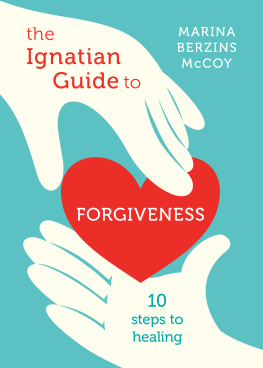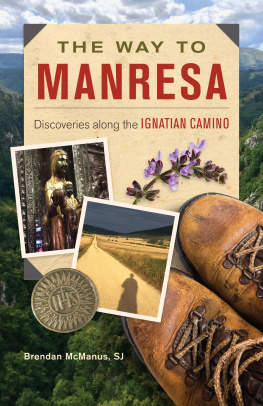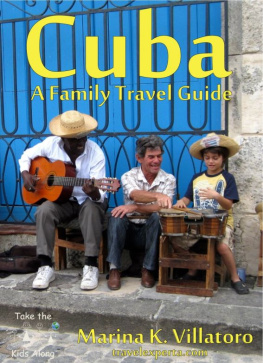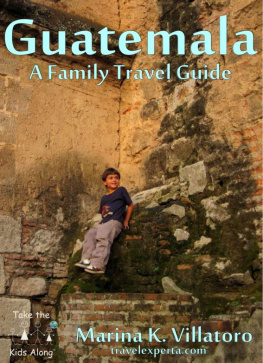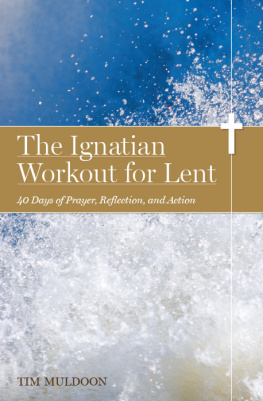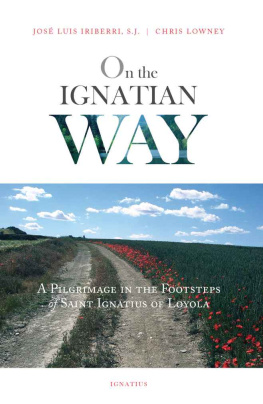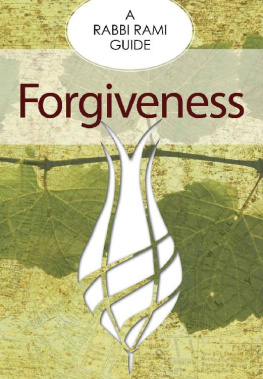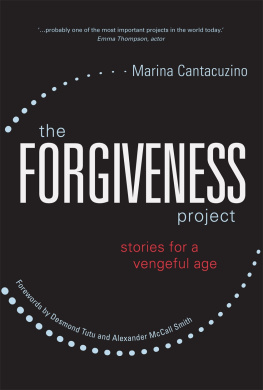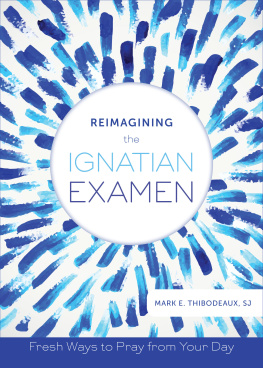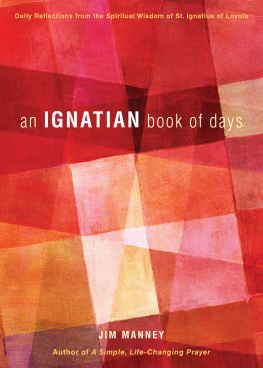Marina Berzins McCoy - The Ignatian Guide to Forgiveness
Here you can read online Marina Berzins McCoy - The Ignatian Guide to Forgiveness full text of the book (entire story) in english for free. Download pdf and epub, get meaning, cover and reviews about this ebook. year: 2020, publisher: Loyola Press, genre: Religion. Description of the work, (preface) as well as reviews are available. Best literature library LitArk.com created for fans of good reading and offers a wide selection of genres:
Romance novel
Science fiction
Adventure
Detective
Science
History
Home and family
Prose
Art
Politics
Computer
Non-fiction
Religion
Business
Children
Humor
Choose a favorite category and find really read worthwhile books. Enjoy immersion in the world of imagination, feel the emotions of the characters or learn something new for yourself, make an fascinating discovery.
- Book:The Ignatian Guide to Forgiveness
- Author:
- Publisher:Loyola Press
- Genre:
- Year:2020
- Rating:3 / 5
- Favourites:Add to favourites
- Your mark:
- 60
- 1
- 2
- 3
- 4
- 5
The Ignatian Guide to Forgiveness: summary, description and annotation
We offer to read an annotation, description, summary or preface (depends on what the author of the book "The Ignatian Guide to Forgiveness" wrote himself). If you haven't found the necessary information about the book — write in the comments, we will try to find it.
The Ignatian Guide to Forgiveness — read online for free the complete book (whole text) full work
Below is the text of the book, divided by pages. System saving the place of the last page read, allows you to conveniently read the book "The Ignatian Guide to Forgiveness" online for free, without having to search again every time where you left off. Put a bookmark, and you can go to the page where you finished reading at any time.
Font size:
Interval:
Bookmark:


3441 N. Ashland Avenue
Chicago, Illinois 60657
(800) 621-1008
www.loyolapress.com
2020 Marina Berzins McCoy
All rights reserved.
Scripture quotations are from the New Revised Standard Version Bible: Catholic Edition, copyright 1989, 1993 National Council of the Churches of Christ in the United States of America. Used by permission. All rights reserved worldwide.
p. 33 Earthen Vessels, 1975, 1978, 1991, John B. Foley, SJ, and OCP. All rights reserved.
p. 154 Lord of the Dance, Words: Sydney Carter, 1963 Stainer & Bell, Ltd. (Admin. Hope Publishing Company, Carol Stream, IL 60188). All rights reserved. Used by permission.
Cover art credit: Praneat/iStock/Getty Images
eBook ISBN: 978-0-8294-5008-8
Based on the print edition: 978-0-8294-5007-1
Library of Congress Control Number: 2020944539
20 21 22 23 24 EPUB 5 4 3 2 1
For John
Have you ever been to a wedding dance in which the bride and groom dance their first dance together as a married couple, alone out on the dance floor? Soon, the bride and groom each invite a parent or other relative to join the dance, and there are four people dancing. Next, other relatives may join in, until soon everyone is out on the floor. It may be surprising to consider a wedding dance as an image of forgiveness. After all, we think of forgiveness as taking place only between two people. Or we may think of forgiveness mostly in terms of shoulds and oughts. I may say to myself, I should forgive this person because God wants me to do so. Or, I am required to forgive, because otherwise maybe God will not forgive me. But forgiveness is not like this. It is much more like a dance, in which our first dance partner is God. But whenever we spend time with God and let God lead us, we are always led back to embrace other peoplefor example, the one whom we forgive or who forgives us. This forgiveness then gives us the freedom to go and live more generously with others in the wider human family. And then we go on to dance the dance of love with them, too.
Jesus himself uses the image of the wedding hall and the party with invited guests. In the Gospel according to Matthew, Jesus presents God as the host of a huge party where he hopes his invited guests will show up (Matthew 22:114). He prepares the best feast for them to enjoy when they arrive. However, many people refuse the invitation. The host of the parable instructs his servants to go out into the street and find new guests. They invite in both good and bad until the banquet hall is full. One imagines people from all walks of life: those with money and those without much. People who dress up and those who like to go casual. There are shy people and more outgoing types; those who have many connections and others still finding them. The host does not have an A-list but instead an all list; the question is, do we show up to the party?
This story recently resonated with me in a new way, when my husband threw a fiftieth birthday party for me. We invited many friends from a variety of parts of our lives: friends from work, friends from grad-school days, neighbors across the street. My best friend was there, and so was a woman we had not seen since college. When the guests sang Happy Birthday, I was happy to be surrounded by so many people who represented a variety of times in my life. But in a quieter moment, after the party ended, one of the guests expressed her happiness at being at the party because it brought together people who otherwise might never have met. A friend who was a social worker met an immigration lawyer and hit it off. A single friend enjoyed playing with my neighbors toddler. My guests comment helped me realize that the best part of the birthday celebration was really not about me but about all the guests who were present, the community that came about by way of the invitation.
This helped me understand Jesus parable in a new way and understand forgiveness in a new way too. This parable shows us that God loves to throw a party and to bring together all the people that God loves: rich and poor, fulfilled and struggling, people from all walks of life. Within each person, too, God loves everything that is gifted and beautiful and everything that is broken and flawed. All parts of ourselves are welcome to the party. God wants us to be able to enjoy the feast, cut the cake, listen to music, and get out on the dance floor together. The party is not for God. The party is for us. The celebration is life with God and with one another.
God invites us to come to the celebration. Forgiveness helps us all to get there. God invites us to feast and to dance. Forgiveness is part of how we make our way deeper into the celebration of community and communion, with God and with one another. Forgiveness helps us find our way back into the freedom and giftedness of life.
This book takes up the notion of forgiveness in terms of ten steps we can take toward forgiving others and ourselves. Forgiveness is not really a straight line, however, nor is there a precise method that can bring us from a place of hurt or anger to a place of forgiveness and peace. It is not like taking an antibiotic for an illness. We dont undertake seven days of a regimen and find that we are simply cured. Forgiveness is much more like walking down a winding path, with some difficult areas that are hard to traverse, places where we cannot see what is ahead of the next turn, and then some delightful moments where the path levels out and suddenly the way is easier. When we walk the path closer to forgiveness, we might find that there are times when we have to stop to rest and take a break. Sometimes the road has a fork in it, and we have to choose which way to take, hoping that this path does not have a dead end but brings us to our destination. Sometimes we even have to retrace our steps to an earlier point on the path because we find that we have forgotten something back there and its too soon to move ahead to the next place. In this way, the journey is more like a meandering dance than a straight line. What matters, though, is that we are on the path.
The ten steps below are offered as a road map. The terrain each one of us travels will have its unique features, specific to each persons dynamics and relationships. For this reason, we need a good guide, one who knows the local area well. Our guide is Jesus. In Scripture, we see that Jesus himself walked the path of forgiveness, offering it to others in his healing ministry, preaching on what it is, and even modeling for us from the cross how to forgive. On the cross, Jesus asks his Father to forgive those who are crucifying him; while he asks his Father to do the work of forgiving, his very desire that those who harm him be forgiven is an act of care for those who have enacted harm (Luke 23:34). In this way, Jesus speaks about forgiveness not simply from the perspective of a divine being but also from the perspective of any human. Jesus makes a good guide for each of us because he knows our inner terrain. He knows what the human landscape looks like inside each of us. Jesus knows us inside and out and has great compassion for the person we areas well as for the person from whom we are alienated.
Ignatian spirituality provides some excellent resources for allowing God to companion us on the journey. Specific forms of praying, such as the examen and imaginative prayer, open up ways for God to communicate with us. Moreover, Ignatius had deep insight into the personal dynamics of spirituality: how we think and feel; how thoughts and feelings can bring us closer to or further away from God; and how prayer can allow God to reshape our vision of ourselves and others. Forgiveness often requires that we delve deeply into our souls and notice what moves them. The philosopher Heraclitus says, One will never discover the limits of the soul, should one travel every road, so deep a measure does it hold. Ignatius understood the great depths of the soul and how God can assist us in navigating its seemingly unfathomable territory.
Font size:
Interval:
Bookmark:
Similar books «The Ignatian Guide to Forgiveness»
Look at similar books to The Ignatian Guide to Forgiveness. We have selected literature similar in name and meaning in the hope of providing readers with more options to find new, interesting, not yet read works.
Discussion, reviews of the book The Ignatian Guide to Forgiveness and just readers' own opinions. Leave your comments, write what you think about the work, its meaning or the main characters. Specify what exactly you liked and what you didn't like, and why you think so.

